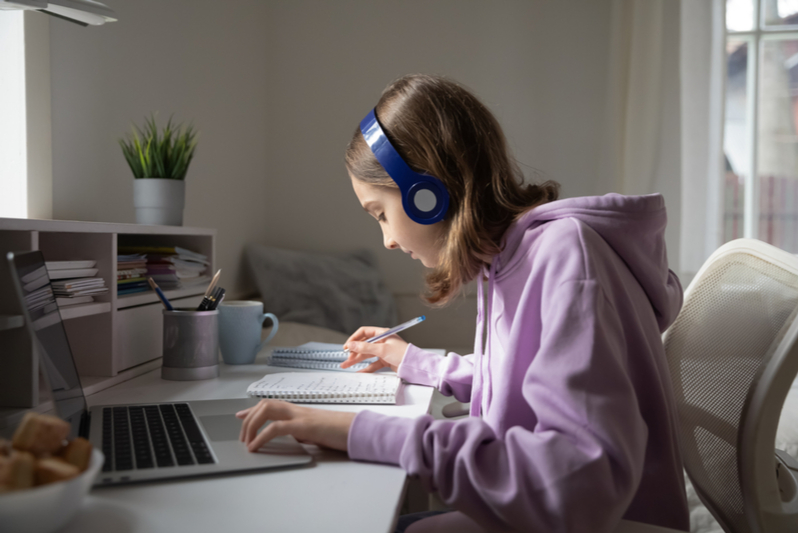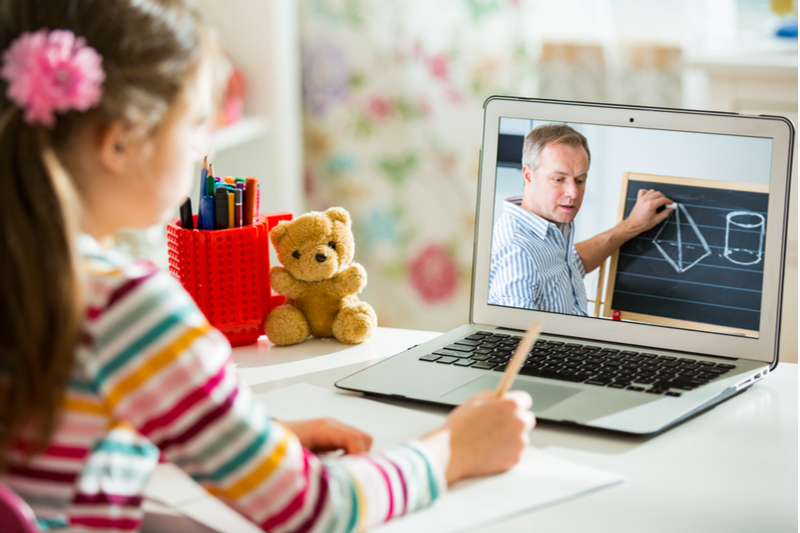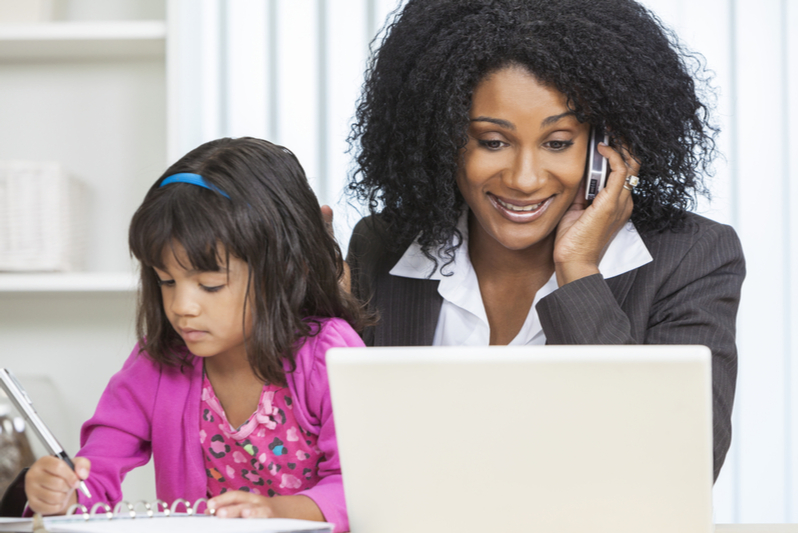Blended or hybrid learning is the name of the game for the school year of 2020-2021, with the coronavirus pandemic showing no signs of leaving, any time soon. The goal is to limit contact, while getting kids an education. Most schools and students will be using a combination of traditional classroom learning along with some form of at-home learning. But this sort of blended/hybrid learning means we will continue to confront the challenges of learning at home, such as wandering student attention, the lack of social interaction, and parents distracted from their work. Taking frequent breaks, one-on-one teacher-student sessions, and opting for interactive tech over the Zoom classroom are some of the ways teachers, students, and parents are making it work.
In the past, parents could depend on the schools to educate their children. Now, with hybrid/blending learning a reality, parents must balance work with overseeing their children’s education. Learning at home is also hard on students, who may miss out on important social interactions with their classmates and teachers. Finally, virtual learning is hard on teachers, who may not be able to tell when a student’s attention has wandered.

Wandering Attention
In the classroom, it’s a cinch for teachers to spot when students have stopped paying attention. But it’s not so easy online. “The challenge facing us educators is that we can’t sense when a student has lost focus, is completely lost, or just doesn’t care. We can’t see their body language on a Zoom call and we have them in person so infrequently,” says Jed Macosko, a teacher and the educational director Academic Influence. “These sessions can be as short as five minutes, but they really help me as an educator to know how my students are doing.”
Using the Right Tech
While many elementary school teachers have experienced frustration engaging young students through online learning, others say that using the right technology makes all the difference. That would include Nancy Penchev, who teaches instructional technology for Kindergarten to Grade 5 students. Penchev has been enjoying what she terms, “incredible success” giving math tutoring classes virtually to a class of 2nd graders. The Miami-based teacher says it’s all about using the right tech to keep young kids engaged, offering fun challenges, and getting parents and families involved in the learning.
Penchev serves as an ambassador for the Osmo Projector App. Used in conjunction with Zoom conferencing, Penchev says the app allows her students to watch on their screens as she writes out calculations and notes on her desktop in real time. It’s kind of like writing on a whiteboard in class and it does sound better than having young students stare passively at a computer screen. But using Osmo requires the use of an iPad tablet, not something every student owns or can purchase, especially during a challenging economic period.

Offering Fun Challenges
Penchev also likes to offer fun challenges for students at home, to keep young students motivated and actively involved while learning remotely. “We had a measurement scavenger hunt where I would spin a wheel of measurements from 5 cm to 100 cm and kids would run around the house finding things that met the length,” says Penchev.
Getting Parents Involved
Enlisting a parent’s or family’s help is crucial, says Penchev, who adds that family involvement makes the learning experience more socially interactive and less passive. Take “scoot” games. Scoot is a type of whole class activity that has kids moving from seat to seat in order to solve problems. “Hide and seek fractions is a scoot game we normally play in class, but since learning is taking place at home, parents hide the cards and students and families find them and figure out the answers,” says Penchev, who adds that she also has families share how they use fractions in real life, so kids can begin to think about practical uses for fractions.
Blended or Hybrid Learning or Doing it All Online?
Jessica Speer writes about social emotional topics for kids and families. She’s also the mother of two daughters, ages 12 and 14, who started hybrid school this week. Back at the beginning of COVID-19, Speer’s daughters found the quick switch to distance learning difficult. “By the end of the school year, both experienced Zoom fatigue and found it difficult to stay engaged and excited about school,” says Speer.
“This fall, our school district offered a hybrid as well as a completely online option. Given their previous on-line experience, my kids really pushed to try the hybrid where they attend school two or three days a week and work at home the others,” says Speer, who did a few things this summer to support her children’s success at school.
Create a Personal Sanctuary
Speer began by redecorating her teenager’s bedroom. “Our teenager feels trapped at home during the pandemic,” says Speer. “To help her feel more comfortable, we redecorated her bedroom into a space she loves and can do her schoolwork in. Since many kids are doing online school from their bedrooms, it’s important for them to feel good about their personal surroundings.”

For Speer’s other daughter, it was all about a single purchase. “My other daughter loves tea, so we got her an electric teapot for her desk. This simple item brings her so much joy as she faces a long day of school work.”
Get Them Outside, Every Day
The mother of two also made efforts to interrupt her daughters’ constant screen time, at least a little, by getting them outside every day. “Screen time is at an all-time high as teens not only engage in learning remotely but try to stay connected with their peers and reduce boredom. I’ve talked to many parents that are concerned that their teens are on devices 10 plus hours a day.
“While it’s important for teens to connect with friends, it’s also important for them to take a break,” says Speer. “I make sure my kids get outside for some fresh air every day they are home. I ask them to walk the dog, do an errand for me, go for a bike ride, or move their bodies. I’ve noticed this little break lifts their mood and helps them find the energy to finish their school work.”

Blended or Hybrid Learning: Understand How Your Child Learns
If there’s anyone who understands the challenges of blended or hybrid schooling, it’s Dana Stahl, M.Ed. Stahl has served as a learning specialist for the past 35 years. Today she’s an education consultant with a specialty in remote learning, and is also an award-winning author. “Managing blended or hybrid schooling requires understanding how your child learns. If your child needs to be redirected to tasks in school, he’ll need to be redirected to tasks at home.
“Is your child an independent learner, or a dependent learner? Independent learners are efficient and effective at maneuvering their ways through assignments,” says Stahl.

Dependent learners, on the other hand, need constant encouragement and direction to make it through their assignments. “Does your child need support to complete tasks? If your child needed parental support with face-to-face learning, he will certainly need you close by now to cheer him on, and to set up tasks in a methodical and manageable manner,” explains Stahl.
It’s no surprise that students benefit from class discussions. “Hopefully,” says Stahl, “the opportunity will exist to engage students in conversations on books they are reading, science observations, and shared methods of solving math problems. If not, have your child partner with a friend to help make learning tangible and meaningful,” suggests the learning consultant.
Ten Effective Strategies for Blended or Hybrid Learning
Stahl offers ten effective teaching strategies to help children feel and be successful at managing blended or hybrid schooling:
- Partner with children as they receive online lessons
- Clarify directions and check for understanding
- Incorporate visual, auditory, and kinesthetic (movement) clues to help your child remain focused
- Remain in physical proximity to your children to help refocus their attention
- Create a workspace free of distractions to increase sustained attention
- Provide headsets to block out surrounding noise
- Break down assignments into manageable components working towards completion
- Encourage breaks, allowing your children to stretch and refocus
- Provide positive reinforcement and rewards for staying on task
- Remain patient
Manage Blended or Hybrid Learning with Organization and Routine
Eileen Carter-Campos is in a unique position to understand the challenges of blended or hybrid learning. Carter-Campos is both a parent and a teacher. The mother of two manages hybrid learning with lots of organization and routine. “Kids must understand that when they’re learning at home, school is still in session. As a teacher, when I work, my children work. It’s nonnegotiable,” says Carter-Campos.
“Of course, there are times when the kids might have a question and I will assist, but for the most part, they know that when I am teaching synchronously or I am in a meeting, they need to work independently as they would in school. This is the only way it has worked for us. We have talk about this, and expectations are set prior to the beginning of school so they know what is expected of them.”
Willie Greer, a product analyst, has two kids now attending school in a blended learning situation. “The tricky thing about this pandemic situation is that there is stuff in brick and mortar education that is pivotal to helping children develop who they are as individuals,” says Greer. “Without personal interaction, children quickly get distracted, and because of their short attention span, it’s more likely that they do not understand anything from their online classes.”
More Hands-On Interaction with Children
Greer solves the problem of kids missing out on interaction with teachers and classmates by being more hands-on with his children. “Spend more time with your kids, even if you have to do it after work hours, to ensure they learned something from all that time they spent in front of a screen.”

The need to get more involved with a child’s education adds more to the parent’s plate, especially if one or both parents work. Greer takes this in stride. “We have to keep in mind that as much as we find blended learning an overwhelming experience, for our children it’s even worse. Parents need to remember this and instead of focusing on their own resentment, try to be a support system for their children, instead.”

But supporting children when you’re struggling to keep up at work and not get fired is not so easy. Actually, none of this is easy. Which is why working parents may find they need an at-home office to make things work—if they can afford to make that happen.
Working Parents: The Need to Close the Door
Perhaps this is why real estate listings with home offices have jumped 10 percent since April 2019. Parents need privacy and peace and quiet to remain productive at work. They need to be able to close the door. How to do this when kids are on the other side of that door, in desperate need of our help and some personal interaction remains a serious dilemma.
What parents are finding out is that blended or hybrid learning, like anything else, has a learning curve. Figuring out what works will take time and practice, which is a lot like learning itself. One thing is certain; parents and children everywhere are all in the same boat. The only thing to do is keep on rowing. We’ll all get there eventually, even if we have to get really, really creative.
